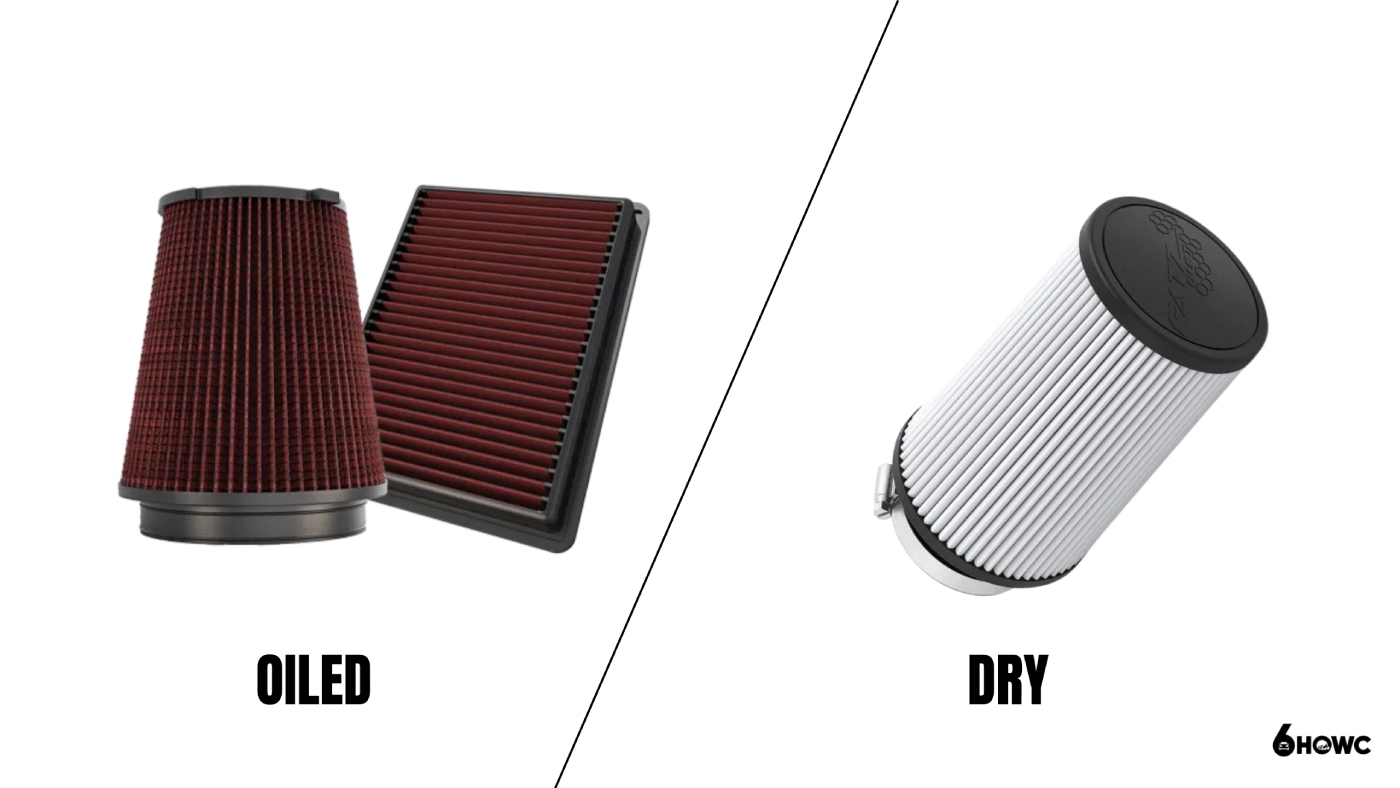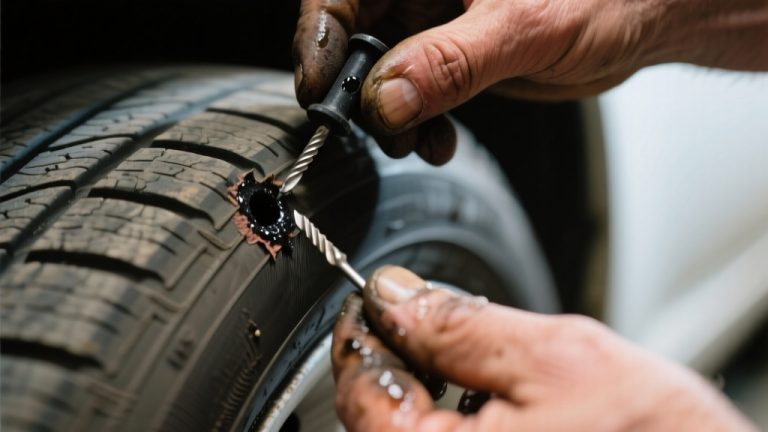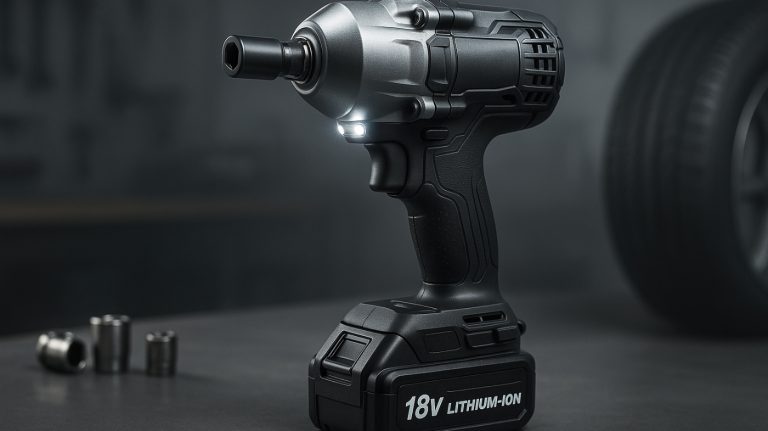When deciding between an oiled and a dry air filter, consider your performance needs and maintenance habits. Oiled filters allow for better airflow and can enhance horsepower, but they require regular cleaning and re-oiling. They capture about 98% of contaminants. In contrast, dry filters, made of paper or foam, trap up to 99% of particles but need replacement every 10,000 to 15,000 miles, which could lead to higher long-term costs. Each option offers unique benefits and challenges that may influence your choice based on driving conditions and personal preference. Exploring further can clarify your best choice.
Key Takeaways
- Oiled filters allow for better airflow and performance gains, while dry filters offer higher filtration efficiency, capturing up to 99% of contaminants.
- Dry filters require replacement every 10,000 to 15,000 miles, whereas oiled filters are washable and reusable with proper maintenance.
- Over-oiling oiled filters can damage mass airflow sensors, necessitating careful application during maintenance.
- Environmental impact favors dry filters due to their cleaner operation and recyclability compared to the potential pollution from oiled filters.
- Driving conditions significantly affect filter choice; dry filters perform better in dusty environments, while oiled filters suit high-performance applications.
Air Filters Overview
When you think about engine performance, it’s crucial to understand the role of air filters. These components are essential for enhancing engine efficiency by filtering incoming air and protecting against contaminants.
Two primary types of air filters exist: dry filters and oiled filters. Dry filters, typically made from paper or foam, excel in filtration efficiency, capturing around 99% of airborne contaminants. This high performance means they greatly contribute to maintaining ideal engine function. However, they require replacement every 10,000 to 15,000 miles, which can add to maintenance costs over time.
In contrast, oiled filters, such as those from DNA filters, consist of cotton coated with oil, providing a slightly lower filtration efficiency of approximately 98%. While they may catch a marginally smaller percentage of contaminants, their advantage lies in being washable and reusable. This feature leads to less frequent maintenance, making them an appealing choice for those who prefer a hands-on approach to upkeep.
Ultimately, the decision between dry and oiled filters hinges on your performance needs, driving conditions, and personal maintenance preferences. Each type plays a crucial role in ensuring your engine operates at its best, so consider these factors carefully.
Characteristics of Dry Filters
Dry filters are highly effective components designed to capture airborne contaminants, utilizing materials like paper or foam to achieve impressive filtration efficiency.
These dry air filters excel in trapping fine particles, making them particularly suitable for drier, dustier climates where contaminants are prevalent. However, they generally exhibit more restrictive airflow compared to oiled filters, which can compromise performance—similar to how drop-in filters work in maintaining filtration efficiency while improving airflow.
This restrictive airflow can lead to reduced engine power and fuel economy, especially when the filter becomes dirty. Evaluating filtration efficiency is essential, as it directly impacts how well the engine performs.
In terms of maintenance, dry filters require replacement every 10,000 to 15,000 miles, as they can’t be cleaned without incurring damage. While they do allow for minor dirt removal using compressed air, this is often just a temporary measure.
It’s important to monitor their condition closely, as clogged filters can considerably impact performance.
Characteristics of Oiled Filters
Oiled filters frequently outperform their dry counterparts in terms of airflow and filtration efficiency. These filters, crafted from cotton gauze and coated with a specially formulated oil, capture approximately 98% of incoming contaminants while allowing for increased airflow. This dual capability makes oiled filters a popular choice for performance enthusiasts, as highlighted by their superior performance and longevity.
However, you must pay attention to maintenance. Regular cleaning and re-oiling, typically required on an annual basis, are vital to maintaining their filtration efficiency. Neglecting this step can lead to issues, particularly with the mass airflow sensor, which can be sensitive to excess oil. When applying oil, it’s important to do so lightly, focusing on the peaks of the filter’s ridges to avoid over-oiling, which can damage sensitive engine components.
One significant advantage of oiled filters is their reusability. You can clean and reuse them indefinitely, resulting in long-term cost savings despite the initial investment.
Keep in mind, though, that improper maintenance may lead to an oily residue accumulating in the intake system, which could impact your engine if left unchecked. Therefore, responsible maintenance is important for peak performance.
Performance Comparisons
When comparing performance, oiled air filters generally excel in airflow efficiency, providing significant horsepower gains, especially in high-output applications.
Similar to how cold air intakes may yield larger gains, oiled filters can enhance engine responsiveness.
However, dry filters offer slightly better filtration effectiveness, capturing more contaminants under dusty conditions.
Ultimately, your choice may hinge on specific driving scenarios and maintenance habits, which can influence the real-world differences between these two filter types.
Airflow Efficiency Differences
The choice between oiled and dry air filters markedly impacts airflow efficiency and overall engine performance. Oiled filters typically feature a less-restrictive design, allowing for better airflow, which is essential for high-output engines. Dyno tests reveal that oiled filters can deliver up to a 20% performance difference compared to dry filters, translating to average horsepower gains around 15 HP.
In contrast, dry filters excel in filtration, effectively trapping up to 99% of contaminants. However, they can become restrictive when dirty, leading to reduced airflow that negatively affects power and fuel economy.
Oiled filters, while capturing about 98% of incoming contaminants, compensate for their slightly lower filtration efficiency with superior airflow, making them ideal for performance applications.
It’s worth noting that the performance differences between these filter types may be negligible for standard driving conditions. Some users report no significant changes when switching from one type to another.
Ultimately, if maximizing airflow efficiency and engine performance is your goal, oiled filters often provide a tangible advantage, especially in performance-oriented settings where airflow is vital.
Filtration Effectiveness Analysis
Choosing the right air filter goes beyond airflow efficiency; it also involves understanding filtration effectiveness. When you compare dry filters and oiled filters, you’ll find that dry filters typically filter about 99% of contaminants, while oiled filters capture around 98%. This slight difference means dry filters are marginally better at trapping particulates, especially in dusty or sandy conditions where their higher filtration efficiency shines.
Oiled filters, with their adhesive oil layer, can effectively capture fine particulates. However, they tend to clog quicker in dirty environments due to the oil’s tackiness, which can hinder performance.
While oiled filters often provide better airflow because of their less restrictive design, this advantage can vary based on your specific vehicle needs and driving conditions.
Ultimately, both filter types can considerably enhance engine performance. Your choice between them should balance filtration effectiveness and airflow requirements.
If you’re frequently driving in clean conditions, an oiled filter may suffice. But in more challenging environments, a dry filter will likely deliver superior filtration, ensuring ideal engine health and performance over time.
Maintenance Considerations
Maintaining your air filter is essential for peak engine performance, and understanding the differences between oiled and dry filters can save you time and hassle.
Oiled air filters require regular cleaning and re-oiling, typically recommended annually. This maintenance guarantees they perform at their best and prevents clogging. However, you need to be cautious with oil application; over-oiling can damage mass airflow (MAF) sensors, which can lead to costly repairs.
In contrast, dry air filters offer a more straightforward maintenance routine. They don’t require cleaning and are simply replaced every 10,000 to 15,000 miles. This convenience can appeal to those who prefer minimal upkeep.
If you choose dry air filters, consider using pre-filter socks to capture larger particles, extending their lifespan and reducing how often you need to replace them.
Ultimately, oiled air filters demand more time and attention, which might deter some users. If you prioritize performance and don’t mind the maintenance, they’re a solid choice.
If you’re looking for ease and simplicity, dry air filters might be the way to go. Understanding these maintenance considerations will help you make the best choice for your vehicle.
Cost Analysis
When weighing your options between oiled and dry air filters, evaluating the costs involved can provide valuable insights into long-term expenses. Oiled filters typically have a lower initial purchase cost, making them more accessible upfront.
However, while dry filters require replacement every 10,000 to 15,000 miles, leading to higher long-term costs, oiled filters can be cleaned and reused indefinitely. This feature offers significant savings over time, especially if you drive frequently.
It’s important to take into account additional costs associated with oiled filters, such as cleaning kits and maintenance supplies. While these add to the overall expenditure, the longevity of oiled filters often offsets these extra expenses.
In your cost analysis, think about your driving habits and maintenance routines. If you drive in harsh conditions or accrue high mileage, the savings on replacements with oiled filters may become more pronounced.
Ultimately, the cost-effectiveness of each filter type hinges on your specific driving environment and maintenance commitment. By evaluating these factors, you can determine which filter aligns best with your budget and performance needs.
User Experiences and Preferences
When choosing between oiled and dry air filters, your experiences may vary considerably based on performance perceptions, maintenance preferences, and environmental considerations.
You might appreciate the increased airflow and horsepower gains from oiled filters, while others prefer the ease of maintenance and lower contamination risks associated with dry filters.
Ultimately, your decision could hinge more on individual driving conditions and values than on strict performance metrics.
Performance Perception Differences
Performance perception plays an essential role in the decision-making process for drivers choosing between oiled and dry air filters. User experiences reveal that while some drivers report performance gains of around 15 HP with oiled filters, others see minimal improvements. This variation often hinges on specific vehicle types and individual driving styles.
Many prefer dry filters, citing concerns about oil contamination affecting mass airflow sensors, which can lead to performance issues over time. Dry filters are also favored for their ease of maintenance and replacement, allowing drivers to prioritize convenience over potential airflow benefits.
Here’s a comparison of user experiences with oiled and dry filters:
| Filter Type | User Experience |
|---|---|
| Oiled Filters | Up to 15 HP gain reported |
| Dry Filters | Easier maintenance and replacement |
| Oiled Filters | Enhanced throttle response |
| Dry Filters | Concerns over mass airflow sensors |
| Oiled Filters | Personal satisfaction varies |
Ultimately, your choice may depend on how much you value performance gains versus maintenance convenience. Each filter type has its advocates, shaped by personal experience and perception.
Maintenance Preference Factors
Choosing between oiled and dry air filters often hinges on maintenance preferences, which can greatly impact user satisfaction. Many drivers find that oiled filters demand more frequent maintenance, including cleaning and re-oiling, which can be a deterrent for those who prioritize convenience.
On the other hand, dry filters are favored for their lower upkeep requirements, allowing for easy replacement without the need for additional maintenance.
Concerns about oil contamination affecting mass airflow sensors (MAFs) also lead many to lean towards dry filters, as they guarantee cleaner operation. Although some users appreciate the improved airflow and performance gains that oiled filters provide, the trade-off often comes down to personal driving habits and the willingness to engage in regular maintenance routines.
Interestingly, experiences vary widely; some individuals report negligible performance differences between the two filter types. This has led many to prefer dry filters, citing their simplicity and lower long-term costs as significant advantages.
Ultimately, your choice may depend on how much time and effort you’re willing to invest in filter maintenance versus the performance gains you seek.
Environmental Impact
When considering air filters, the environmental impact of oiled versus dry models plays an essential role in making an informed choice. Oiled filters can contribute to pollution due to oil residues that may enter the air intake system, potentially contaminating surrounding environments if not properly maintained. Their maintenance requires cleaning solutions and oils, which can harm water sources if disposed of incorrectly.
In contrast, dry filters typically have a lower environmental impact. They avoid the use of oils, considerably reducing the risk of contamination and ensuring cleaner disposal. Many dry filters are designed for easy washing and reuse, promoting sustainability compared to the frequent disposal of traditional disposable filters.
Here’s a comparison of the environmental impact of oiled and dry filters:
| Feature | Oiled Filters | Dry Filters |
|---|---|---|
| Pollution Risk | High | Low |
| Maintenance Requirements | High (oils/cleaners) | Low (washable/reusable) |
| Resource Consumption | Higher (production) | Lower (disposable options) |
| Longevity | Longer-lasting | Often disposable |
| Environmental Sustainability | Moderate | High |
Choosing the right filter means weighing these factors carefully.
Choosing the Right Filter
Selecting the right air filter involves evaluating several critical factors that directly impact your vehicle’s performance and maintenance. When deciding between oiled and dry filters, consider your engine’s requirements. Oiled filters typically enhance airflow, making them suitable for high-output or heavily-modified engines.
However, if you prioritize filtration efficiency, dry filters capture about 99% of contaminants, ideal for dusty or dirty environments. Your driving conditions greatly influence your choice. If you frequently navigate sandy or silty areas, a dry filter’s superior filtration capabilities may be more beneficial.
Consider your maintenance preferences as well. Oiled filters necessitate regular cleaning and re-oiling, which could lead to complications, such as MAF sensor contamination, if neglected. On the other hand, dry filters only need replacement every 10,000 to 15,000 miles, providing a more hassle-free option.
Ultimately, weigh the importance of airflow against filtration efficiency and maintenance demands. By understanding your driving habits and maintenance willingness, you can make an informed decision that optimizes your vehicle’s performance while minimizing long-term costs.
Frequently Asked Questions
Which Is Better, a Dry or Oiled Air Filter?
When deciding which air filter is better, you should consider filtration efficiency, airflow, and maintenance.
Dry filters excel in trapping contaminants, making them ideal for dusty conditions. Oiled filters, however, enhance airflow, potentially boosting engine performance.
Maintenance frequency is another factor; dry filters need regular replacements, while oiled filters require annual cleaning.
Weigh these aspects against your needs and preferences to determine which option aligns best with your vehicle’s requirements and your lifestyle.
Do Oiled Air Filters Damage the MAF?
Yes, oiled air filters can damage the MAF sensor if they’re over-oiled.
When you apply too much oil, it can migrate into the intake system, coating the sensor and disrupting its readings. This can lead to inaccurate airflow measurements and performance issues.
To prevent this, make sure you only lightly coat the filter’s ridges and perform regular maintenance.
Proper care can meaningfully reduce the risk of MAF sensor fouling.
What Is the Purpose of an Oiled Air Filter?
Think of an oiled air filter as your engine’s lungs, breathing in cleaner air.
Its primary purpose is to enhance airflow while trapping dirt and particulates, achieving about 98% filtration efficiency.
The porous cotton media, coated with oil, captures fine particles, ensuring your engine remains clean and performs at its best.
Plus, these filters are washable and reusable, offering long-term savings and improved throttle response, especially for high-output engines.
Regular maintenance keeps it functioning effectively.
Are Air Filters Supposed to Be Oiled?
Air filters aren’t universally supposed to be oiled; it depends on the type you’re using.
Oiled filters require oil to enhance their filtration efficiency, while dry filters don’t need oil at all. If you’re using an oiled filter, it’s vital to maintain it by cleaning and re-oiling regularly.
However, over-oiling can cause performance issues, so careful application is necessary. Always follow manufacturer guidelines to guarantee peak performance of your specific air filter type.
Airflow vs. Convenience: Navigating the Oiled vs. Dry Air Filter Debate
In choosing between oiled and dry air filters, you’re managing nuances that can greatly sway your vehicle’s performance. Oiled filters offer ideal airflow and filtration but demand diligent maintenance, while dry filters provide convenience and cleanliness with less hassle. Ultimately, your decision should align with your driving habits, budget, and environmental values. Weighing these factors will help you make a wise, well-informed choice—ensuring your engine breathes beautifully and operates efficiently.




